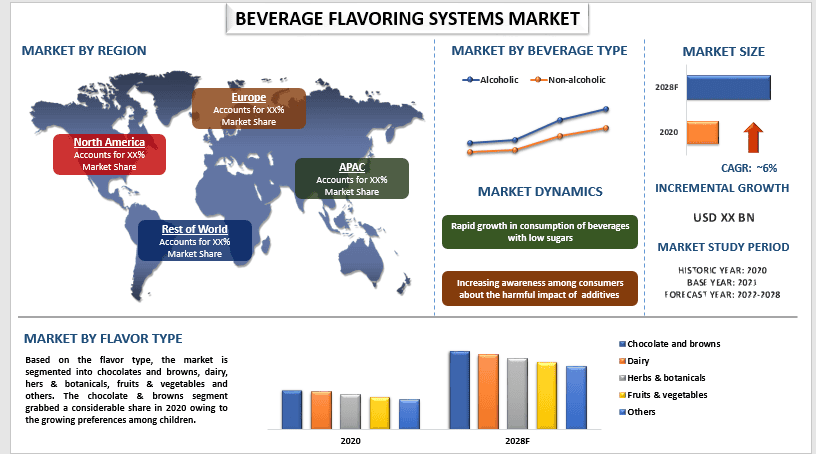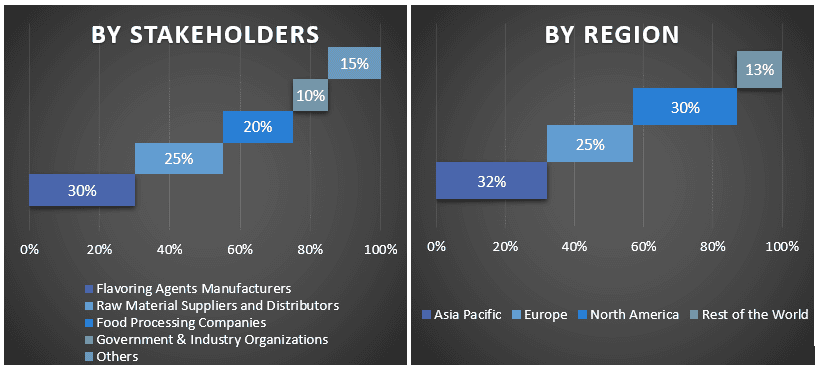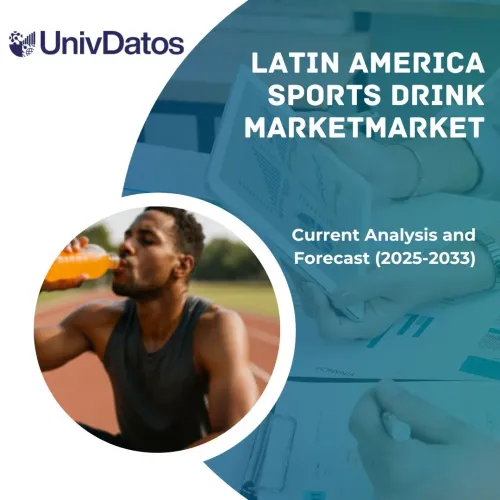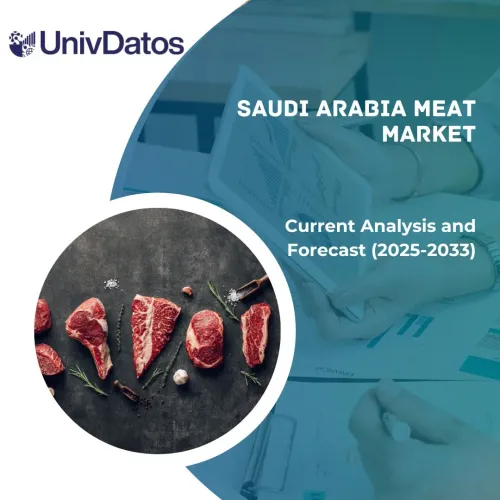- Accueil
- À propos de nous
- Industrie
- Services
- Lecture
- Contactez-nous
Marché des systèmes d'arômes pour boissons : Analyse actuelle et prévisions (2022-2028)
Accent sur le type de boisson (alcoolisée, non alcoolisée) ; Forme (sèche, liquide) ; Type d'ingrédients (agents aromatisants, supports aromatisants, exhausteurs de goût, autres) ; Origine (artificielle, naturelle) ; Type de saveur (chocolat et bruns, produits laitiers, herbes et plantes, fruits et légumes, autres) ; Région/Pays.

Le marché mondial des systèmes d'arômes pour boissons devrait croître à un rythme significatif d'environ 6 % au cours de la période de prévision. L'augmentation des dépenses par habitant des consommateurs en produits alimentaires dans le monde entier les a incités à consommer des boissons saines, biologiques et naturelles, ce qui contribue à la croissance du marché des systèmes d'arômes pour boissons. Par exemple, en 2019, le Japon est le pays où les dépenses par habitant en produits alimentaires sont les plus élevées, soit 4 417,5 USD par personne, suivi de l'Australie, du Canada et de la France, avec des dépenses par personne de 3 003,6 USD, 2 986,9 USD et 2 983,4 USD, respectivement. Il y a un besoin croissant de boissons saines de la part des sportifs et des athlètes, ce qui explique l'augmentation de la demande de systèmes d'arômes pour boissons.
En outre, l'augmentation du nombre de cafés, d'hôtels et de restaurants dans la région Asie-Pacifique, associée à la sensibilisation croissante aux bienfaits des boissons biologiques pour la santé, entraîne la croissance du marché des systèmes d'arômes pour boissons. De plus, les fabricants d'arômes adoptent de nouvelles technologies, en particulier pour fabriquer des arômes naturels et synthétiques afin d'améliorer la stabilité et l'efficacité de la production d'arômes. L'extraction des arômes à partir des ingrédients sources est une procédure complexe. Par conséquent, les fabricants adoptent diverses méthodes avancées telles que la biotechnologie, l'encapsulation et l'émulsion pour augmenter l'efficacité des arômes.
ADM, Givaudan, Sensient Technologies Corporation, Kerry Group, International Flavors and Fragrances Inc., Firmenich SA, Takasago International Corporation, Flavorchem & Orchidia Fragrances, Tate & Lyle Plc, Döhler, etc., sont quelques-uns des principaux acteurs du marché. Plusieurs fusions et acquisitions ainsi que des partenariats ont été entrepris par ces acteurs pour fournir aux clients des produits/technologies de haute technologie et innovants.
Aperçus présentés dans le rapport
« Parmi les types de boissons, la catégorie des boissons non alcoolisées devrait connaître le TCAC le plus élevé au cours de la période de prévision »
Selon le type, le marché est segmenté en boissons alcoolisées et non alcoolisées. Le segment des boissons non alcoolisées a accaparé la part de marché la plus importante et a dominé le marché en 2020. La sensibilisation croissante aux avantages pour la santé associés aux boissons non alcoolisées, en particulier chez les milléniaux, contribue à la croissance du segment. En outre, le nombre croissant de fanatiques de la santé à travers le monde soutient la demande de boissons énergisantes et de boissons pour sportifs, agissant comme un catalyseur de croissance pour ce segment. De plus, la variété croissante de boissons non alcoolisées telles que les boissons énergisantes, le lait aromatisé, l'eau aromatisée, les cocktails sans alcool et les jus, etc., soutient davantage la part de revenus maximale du segment sur le marché des systèmes d'arômes pour boissons.
« Parmi les formes, la catégorie des liquides devrait connaître le TCAC le plus élevé au cours de la période de prévision »
Selon la forme, le marché est segmenté en sec et liquide. Le segment des liquides a accaparé la part de marché la plus importante et a dominé le marché en 2020. Le segment devrait également maintenir sa domination au cours de la période de prévision. La facilité de traitement associée aux arômes liquides contribue principalement à sa domination sur le marché des systèmes d'arômes pour boissons. Cette capacité de mélange facile offre une stabilité accrue qui conduit à sa préférence par les fabricants de boissons.
« Parmi les types d'ingrédients, les agents aromatisants devraient détenir une part importante du marché en 2020 »
Sur la base du type d'ingrédients, le marché est classé en agents aromatisants, supports d'arômes, exhausteurs de goût et autres. Parmi ceux-ci, le segment des agents aromatisants a accaparé la part de marché la plus importante et a dominé le marché en 2020. Les agents aromatisants sont ajoutés pour modifier, amplifier ou compléter le goût et l'arôme des boissons. L'expérimentation croissante dans les boissons pour offrir de la variété aux consommateurs contribue à la croissance de ce segment. Certains des agents aromatisants courants utilisés dans la formation de boissons comprennent les alcools, les esters, les aldéhydes, le MSG, les hydrolysats de protéines et les cétones.
« Parmi les origines, la catégorie naturelle devrait connaître le TCAC le plus élevé au cours de la période de prévision »
Sur la base de l'origine, le marché est classé comme artificiel et naturel. Le segment d'origine naturelle a capturé la part de marché la plus importante. Les arômes d'origine naturelle sont plus sûrs pour la consommation humaine que leurs homologues chimiques. Les ingrédients aromatisants synthétisés chimiquement entraînent souvent des risques pour la santé tels que des allergies ou des maladies chroniques telles que les cancers. De plus, les ingrédients d'origine naturelle sont également écologiques car ils ne contribuent pas à une grave pollution de l'environnement par rapport aux arômes artificiels lors de la production ou de l'élimination. En conséquence, l'attention des fabricants de boissons s'oriente vers l'utilisation d'ingrédients d'origine naturelle, également en raison de la demande croissante des consommateurs pour des produits respectueux de l'environnement.
« Parmi les types d'arômes, les agents aromatisants devraient détenir une part importante du marché en 2020 »
Sur la base du type d'arôme, le marché est segmenté en chocolat et bruns, produits laitiers, herbes et plantes, fruits et légumes, et autres. Le segment du chocolat et des herbes a accaparé une part de marché considérable en 2020. La demande croissante de produits à base de cacao, en particulier chez les enfants et les jeunes, les milléniaux, ajoute du rythme à la croissance du marché. Cependant, le segment des herbes et des plantes croîtrait à un rythme soutenu en raison de la demande croissante de boissons saines.
« L'Asie-Pacifique devrait détenir une part importante du marché »
En 2020, l'Asie-Pacifique détenait une part importante du marché mondial des systèmes d'arômes pour boissons. L'augmentation du nombre de cafés, d'hôtels et de restaurants dans la région, associée à l'adoption de la culture occidentale, entraîne une demande croissante pour le marché des systèmes d'arômes pour boissons. De plus, la croissance de l'industrie du voyage et du tourisme et l'attrait croissant des restaurants à service rapide (QSR) chez les milléniaux. Selon Statista, le nombre d'établissements de restauration dans le monde variait considérablement selon la région en 2020. L'Asie-Pacifique comptait le plus d'établissements avec plus de 17 millions. En comparaison, la région avec le deuxième plus grand nombre d'établissements de restauration était l'Amérique latine avec plus de 2,3 millions.
Raisons d'acheter ce rapport :
- L'étude comprend une analyse de la taille du marché et des prévisions validées par des experts clés authentifiés de l'industrie.
- Le rapport présente un aperçu rapide de la performance globale de l'industrie en un coup d'œil.
- Le rapport couvre une analyse approfondie des pairs de l'industrie de premier plan en mettant l'accent sur les principales données financières de l'entreprise, le portefeuille de produits, les stratégies d'expansion et les développements récents.
- Examen détaillé des moteurs, des contraintes, des tendances clés et des opportunités qui prévalent dans l'industrie.
- L'étude couvre de manière exhaustive le marché à travers différents segments.
- Analyse approfondie au niveau régional de l'industrie.
Options de personnalisation :
Le marché mondial des systèmes d'arômes pour boissons peut être davantage personnalisé selon les besoins ou tout autre segment de marché. En outre, UMI comprend que vous pouvez avoir vos propres besoins commerciaux, n'hésitez donc pas à nous contacter pour obtenir un rapport qui correspond parfaitement à vos besoins.
Table des matières
Méthodologie de recherche pour l'analyse du marché des systèmes d'arômes pour boissons (2022-2028)
L'analyse du marché historique, l'estimation du marché actuel et la prévision du marché futur du marché mondial des systèmes d'arômes pour boissons ont été les trois principales étapes entreprises pour créer et analyser l'adoption des systèmes d'arômes pour boissons dans les principales régions du monde. Une recherche secondaire exhaustive a été menée pour collecter les chiffres du marché historique et estimer la taille actuelle du marché. Deuxièmement, pour valider ces informations, de nombreuses conclusions et hypothèses ont été prises en considération. De plus, des entretiens primaires exhaustifs ont également été menés avec des experts de l'industrie à travers la chaîne de valeur du marché mondial des systèmes d'arômes pour boissons. Après l'hypothèse et la validation des chiffres du marché grâce à des entretiens primaires, nous avons utilisé une approche descendante/ascendante pour prévoir la taille complète du marché. Par la suite, des méthodes de ventilation du marché et de triangulation des données ont été adoptées pour estimer et analyser la taille du marché des segments et sous-segments de l'industrie concernée. La méthodologie détaillée est expliquée ci-dessous :
Analyse de la taille du marché historique
Étape 1 : Étude approfondie des sources secondaires :
Une étude secondaire détaillée a été menée pour obtenir la taille du marché historique du marché des systèmes d'arômes pour boissons par le biais de sources internes à l'entreprise telles que les rapports annuels et états financiers, présentations de performance, communiqués de presse, etc., et de sources externes, y compris les revues, actualités et articles, publications gouvernementales, publications des concurrents, rapports sectoriels, base de données tierce et autres publications crédibles.
Étape 2 : Segmentation du marché :
Après avoir obtenu la taille du marché historique du marché des systèmes d'arômes pour boissons, nous avons mené une analyse secondaire détaillée pour recueillir des informations sur le marché historique et la part des différents segments et sous-segments pour les principales régions. Les principaux segments inclus dans le rapport sont le type de boisson, la forme, l'origine, le type d'ingrédients et le type d'arôme. Des analyses plus approfondies au niveau des pays ont été menées pour évaluer l'adoption globale des modèles de test dans cette région.
Étape 3 : Analyse des facteurs :
Après avoir acquis la taille du marché historique des différents segments et sous-segments, nous avons mené une analyse des facteurs détaillée pour estimer la taille actuelle du marché des systèmes d'arômes pour boissons. De plus, nous avons mené une analyse des facteurs en utilisant des variables dépendantes et indépendantes telles que le type de boisson, la forme, l'origine, le type d'ingrédients et le type d'arôme des systèmes d'arômes pour boissons. Une analyse approfondie a été menée pour les scénarios de demande et d'offre en tenant compte des principaux partenariats, fusions et acquisitions, expansions commerciales et lancements de produits sur le marché des systèmes d'arômes pour boissons à travers le monde.
Estimation et prévision de la taille actuelle du marché
Dimensionnement actuel du marché : Sur la base d'informations exploitables tirées des 3 étapes ci-dessus, nous sommes parvenus à la taille actuelle du marché, aux principaux acteurs du marché mondial des systèmes d'arômes pour boissons et aux parts de marché des segments. Tous les pourcentages de parts requis et les ventilations du marché ont été déterminés à l'aide de l'approche secondaire susmentionnée et ont été vérifiés par le biais d'entretiens primaires.
Estimation et prévision : Pour l'estimation et la prévision du marché, des pondérations ont été attribuées à différents facteurs, notamment les moteurs et les tendances, les contraintes et les opportunités disponibles pour les parties prenantes. Après avoir analysé ces facteurs, les techniques de prévision pertinentes, c'est-à-dire l'approche descendante/ascendante, ont été appliquées pour parvenir à la prévision du marché pour 2028 pour différents segments et sous-segments sur les principaux marchés mondiaux. La méthodologie de recherche adoptée pour estimer la taille du marché comprend :
- La taille du marché de l'industrie, en termes de revenus (USD) et le taux d'adoption du marché des systèmes d'arômes pour boissons sur les principaux marchés nationaux
- Tous les pourcentages de parts, les divisions et les ventilations des segments et sous-segments de marché
- Les principaux acteurs du marché mondial des systèmes d'arômes pour boissons en termes de produits offerts. De plus, les stratégies de croissance adoptées par ces acteurs pour concurrencer sur le marché en croissance rapide
Validation de la taille et de la part du marché
Recherche primaire : Des entretiens approfondis ont été menés avec les principaux leaders d'opinion (KOL), y compris les cadres supérieurs (CXO/VP, chef des ventes, chef du marketing, chef des opérations, chef régional, chef de pays, etc.) dans les principales régions. Les résultats de la recherche primaire ont ensuite été résumés et une analyse statistique a été effectuée pour prouver l'hypothèse énoncée. Les contributions de la recherche primaire ont été regroupées avec les résultats secondaires, transformant ainsi l'information en informations exploitables.
Répartition des participants primaires dans différentes régions

Ingénierie de marché
La technique de triangulation des données a été utilisée pour compléter l'estimation globale du marché et pour parvenir à des chiffres statistiques précis pour chaque segment et sous-segment du marché mondial des systèmes d'arômes pour boissons. Les données ont été divisées en plusieurs segments et sous-segments après avoir étudié divers paramètres et tendances dans le type de boisson, la forme, l'origine, le type d'ingrédients et le type d'arôme sur le marché mondial des systèmes d'arômes pour boissons.
L'objectif principal de l'étude du marché mondial des systèmes d'arômes pour boissons
Les tendances actuelles et futures du marché mondial des systèmes d'arômes pour boissons ont été mises en évidence dans l'étude. Les investisseurs peuvent obtenir des informations stratégiques pour fonder leur discrétion en matière d'investissements sur l'analyse qualitative et quantitative effectuée dans l'étude. Les tendances actuelles et futures du marché ont déterminé l'attractivité globale du marché au niveau régional, offrant une plateforme aux participants industriels pour exploiter le marché inexploité afin de bénéficier d'un avantage de premier entrant. Les autres objectifs quantitatifs des études comprennent :
- Analyser la taille actuelle et prévue du marché des systèmes d'arômes pour boissons en termes de valeur (USD). De plus, analyser la taille actuelle et prévue du marché des différents segments et sous-segments
- Les segments de l'étude comprennent les domaines du type de boisson, de la forme, de l'origine, du type d'ingrédients et du type d'arôme.
- Définir et analyser le cadre réglementaire des systèmes d'arômes pour boissons
- Analyser la chaîne de valeur impliquée avec la présence de divers intermédiaires, ainsi qu'analyser les comportements des clients et des concurrents de l'industrie.
- Analyser la taille actuelle et prévue du marché des systèmes d'arômes pour boissons pour la région principale.
- Les principaux pays des régions étudiées dans le rapport comprennent l'Asie-Pacifique, l'Europe, l'Amérique du Nord et le reste du monde.
- Profils d'entreprise du marché des systèmes d'arômes pour boissons et stratégies de croissance adoptées par les acteurs du marché pour se maintenir sur le marché en croissance rapide
- Analyse approfondie au niveau régional de l'industrie
Connexes Rapports
Les clients qui ont acheté cet article ont également acheté










